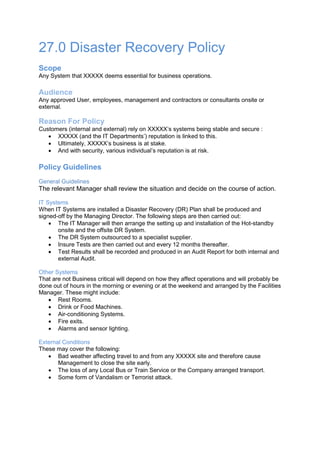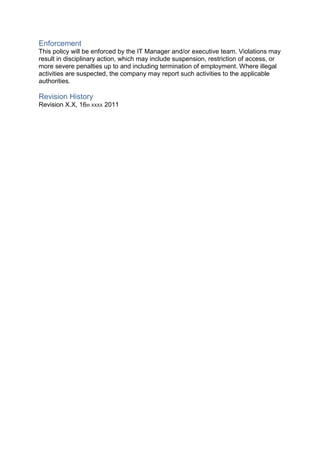Disaster recovery policy
- 1. 27.0 Disaster Recovery Policy Scope Any System that XXXXX deems essential for business operations. Audience Any approved User, employees, management and contractors or consultants onsite or external. Reason For Policy Customers (internal and external) rely on XXXXXŌĆÖs systems being stable and secure : ’éĘ XXXXX (and the IT DepartmentsŌĆÖ) reputation is linked to this. ’éĘ Ultimately, XXXXXŌĆÖs business is at stake. ’éĘ And with security, various individualŌĆÖs reputation is at risk. Policy Guidelines General Guidelines The relevant Manager shall review the situation and decide on the course of action. IT Systems When IT Systems are installed a Disaster Recovery (DR) Plan shall be produced and signed-off by the Managing Director. The following steps are then carried out: ’éĘ The IT Manager will then arrange the setting up and installation of the Hot-standby onsite and the offsite DR System. ’éĘ The DR System outsourced to a specialist supplier. ’éĘ Insure Tests are then carried out and every 12 months thereafter. ’éĘ Test Results shall be recorded and produced in an Audit Report for both internal and external Audit. Other Systems That are not Business critical will depend on how they affect operations and will probably be done out of hours in the morning or evening or at the weekend and arranged by the Facilities Manager. These might include: ’éĘ Rest Rooms. ’éĘ Drink or Food Machines. ’éĘ Air-conditioning Systems. ’éĘ Fire exits. ’éĘ Alarms and sensor lighting. External Conditions These may cover the following: ’éĘ Bad weather affecting travel to and from any XXXXX site and therefore cause Management to close the site early. ’éĘ The loss of any Local Bus or Train Service or the Company arranged transport. ’éĘ Some form of Vandalism or Terrorist attack.
- 2. Enforcement This policy will be enforced by the IT Manager and/or executive team. Violations may result in disciplinary action, which may include suspension, restriction of access, or more severe penalties up to and including termination of employment. Where illegal activities are suspected, the company may report such activities to the applicable authorities. Revision History Revision X.X, 16th XXXX 2011


